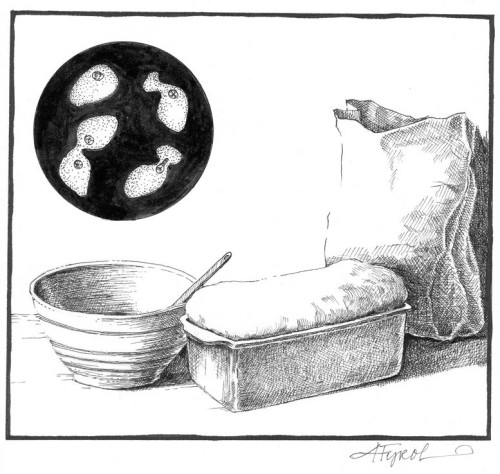
Bacteria – and other micro-organisms – get a bad rap. All winter long, we wash our hands to keep them away. We sanitize our dishes in a dishwasher, our clothes in the washing machine, and our bodies in the shower. We consider microorganisms to be “germs” and want to keep those little critters off us.
But the reality is, we couldn’t live without them. Bacteria and other microorganisms, like yeast, make life not only possible but also pleasurable.
In fact, the vast majority of microorganisms are helpful to humans; no food of any kind could grow without them. Only a small number are the disease-carrying villains that we automatically think of when we hear the word “bacteria.”
Think of some of life’s great gustatory pleasures – a loaf of fresh bread, a glass of wine or beer, a slab of cheese, all deliberately created with the collaboration of certain microorganisms. And since a good deal of our local economy depends upon the production of dairy products, like cheese and yogurt, we should consider ourselves as having a vested interest in the well-being of our tiny bacterial allies.
To begin with, no animal, ourselves included, could digest its food without bacteria – specifically, the trillions of one-celled organisms that live within the gut of every creature that walks, swims, splashes or flies. Special bacteria living in the multiple stomachs of cattle allow them to break down cellulose and thereby digest grass. Hence, we owe our glass of milk to the presence of bacteria as well as the presence of cows.
Roughly one-third of the total number of bacteria in the human system are members of the bacteroides group, which produce enzymes that digest the cell walls of vegetables, allowing us to absorb the vegetable’s nutritional elements. Other bacteria in our bodies produce important vitamins, and certain bacteria even prevent the growth of other bacteria that could make us sick.
Some bacteria, of course, can have unpleasant and even life-ending consequences for us. They cause odor. Bacteria on tongue, teeth, and gums give off waste that causes bad breath. Our bodies eventually become covered with skin-borne and airborne bacteria that die and become smelly. By the time we towel ourselves dry after a shower, new microbes already have begun setting up shop.
In our kitchen, we must guard against food poisoning from salmonella and botulism. Airborne bacteria can cause strep infections and tuberculosis, and sexually transmitted bacteria can cause syphilis and gonorrhea. (Many diseases, from the common cold to AIDS, are caused not by bacteria but by viruses, which are altogether different. Viruses, most of which are 100 times smaller than bacteria, are not organisms at all but a type of genetic material that can enter our cells and kill them.)
But most bacteria and many other microorganisms help us in stunningly broad and complex ways – from enriching our garden soil with nitrogen to decomposing our waste in sewer plants.
Among the bacteria we find helpful are lactobacillae – without which we wouldn’t have much of a dairy industry. When Lactobacillus cremoris and certain molds make their way into milk, or are carefully introduced, delicious cheeses can result. Lactic acid bacteria (LAB) help make cheese by fermenting the milk’s lactose (milk sugar) into lactic acid, which assists coagulation and contributes to the flavor and consistency of the cheese. Lactobacteria also slow the spoiling of cheese and prevent the growth of pathogenic bacteria. Molds in certain cheeses are evident to the eye – they form the blue streaks we see in blue cheeses—and certainly pleasing to the taste buds.
Yeasts, used by mankind for thousands of years, were probably the first type of microbe to be used for domestic purposes. A particular kind of yeast, Saccheromyces cerevisiae, makes bread rise by producing gases as they metabolize and reproduce. There is something highly satisfying about being in a warm kitchen on a cold day and watching a quiescent mass of water, flour, and yeast change and swell and become loaf-like. It’s food that is literally alive – until we eventually kill all the yeasts within the bread by baking it.
As yeasts metabolize, they can also convert carbohydrates into another welcome by-product: alcohol. Home brewers and the region’s micro-breweries would be at a loss without brewers’ yeast.
So, go ahead and wash your hands to protect against those dangerous “germs.” You really should. But don’t forget that it’s our tiny microbial allies that you must thank for your tasty lunch of bread, cheese, and beer.

